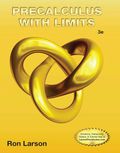
a .
To write: the linear equation giving the total cost C of operating the equipment for t hours.
a .
Answer to Problem 99E
Explanation of Solution
Given:
Cost of delivery truck is $42,000.
Average expenditure on fuel and maintenance is $9.50 per hour.
Operator is paid $11.50 per hour.
Total cost C of operating the equipment for t hours is:
C = cost of delivery truck + cost of fuel and maintenance + cost of operator
b.
To write:the equation for the revenue R obtained from t hours of use.
b.
Answer to Problem 99E
Explanation of Solution
Given:
Customers are charged $45 per hour of machine use.
Revenue = Hourly rate
Since machine is used for t hours at the rate $45 per hour. So, revenue function is given by:
c.
To find: the equation for the profit obtained from t hours of use.
c.
Answer to Problem 99E
Explanation of Solution
From part (a), the cost function is given by
From part (b), the revenue function is given by
Now, it is known that,
Profit = Revenue − Cost
d.
To find: the break-even point.
d.
Answer to Problem 99E
Explanation of Solution
Break-even point is the number of hours for which the machine should be operated to yield $0 profit.
So, the objective is to find t for which
Consider,
Thus, the equipment should be used for 1,750 hours to be break-even, that is to obtian $0 profit.
Chapter 1 Solutions
EBK PRECALCULUS W/LIMITS
- A 20 foot ladder rests on level ground; its head (top) is against a vertical wall. The bottom of the ladder begins by being 12 feet from the wall but begins moving away at the rate of 0.1 feet per second. At what rate is the top of the ladder slipping down the wall? You may use a calculator.arrow_forwardExplain the focus and reasons for establishment of 12.4.1(root test) and 12.4.2(ratio test)arrow_forwarduse Integration by Parts to derive 12.6.1arrow_forward
- Explain the relationship between 12.3.6, (case A of 12.3.6) and 12.3.7arrow_forwardExplain the key points and reasons for the establishment of 12.3.2(integral Test)arrow_forwardUse 12.4.2 to determine whether the infinite series on the right side of equation 12.6.5, 12.6.6 and 12.6.7 converges for every real number x.arrow_forward
- use Corollary 12.6.2 and 12.6.3 to derive 12.6.4,12.6.5, 12.6.6 and 12.6.7arrow_forwardExplain the focus and reasons for establishment of 12.5.1(lim(n->infinite) and sigma of k=0 to n)arrow_forwardExplain the focus and reasons for establishment of 12.5.3 about alternating series. and explain the reason why (sigma k=1 to infinite)(-1)k+1/k = 1/1 - 1/2 + 1/3 - 1/4 + .... converges.arrow_forward
 Calculus: Early TranscendentalsCalculusISBN:9781285741550Author:James StewartPublisher:Cengage Learning
Calculus: Early TranscendentalsCalculusISBN:9781285741550Author:James StewartPublisher:Cengage Learning Thomas' Calculus (14th Edition)CalculusISBN:9780134438986Author:Joel R. Hass, Christopher E. Heil, Maurice D. WeirPublisher:PEARSON
Thomas' Calculus (14th Edition)CalculusISBN:9780134438986Author:Joel R. Hass, Christopher E. Heil, Maurice D. WeirPublisher:PEARSON Calculus: Early Transcendentals (3rd Edition)CalculusISBN:9780134763644Author:William L. Briggs, Lyle Cochran, Bernard Gillett, Eric SchulzPublisher:PEARSON
Calculus: Early Transcendentals (3rd Edition)CalculusISBN:9780134763644Author:William L. Briggs, Lyle Cochran, Bernard Gillett, Eric SchulzPublisher:PEARSON Calculus: Early TranscendentalsCalculusISBN:9781319050740Author:Jon Rogawski, Colin Adams, Robert FranzosaPublisher:W. H. Freeman
Calculus: Early TranscendentalsCalculusISBN:9781319050740Author:Jon Rogawski, Colin Adams, Robert FranzosaPublisher:W. H. Freeman
 Calculus: Early Transcendental FunctionsCalculusISBN:9781337552516Author:Ron Larson, Bruce H. EdwardsPublisher:Cengage Learning
Calculus: Early Transcendental FunctionsCalculusISBN:9781337552516Author:Ron Larson, Bruce H. EdwardsPublisher:Cengage Learning





